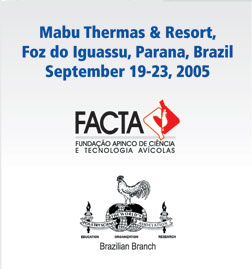Contributed Papers: Oral Presentations
Molecular biology and Biochemistry |
The
Macrophage Inhibitory Factor of Eimeria species
Miska, KB., Lillehoj, HS., Allen, PA.,
Fetterer, RH, and Jenkins, MC.
USDA/ARS, Animal Parasitic Diseases Laboratory
10300 Baltimore Ave, Beltsville, MD 20705 U.S.A
Development of drug resistance
and the paucity of new chemotherapeutic agents have
increased the need for new drugs as well as vaccine
targets against poultry coccidiosis. One approach
used in identifying novel targets is the random screening
of transcripts expressed during the invasive stages
of the parasite life cycle. While screening a cDNA
library derived from merozoites of Eimeria acervulina
a single full-length clone was isolated, and this
shared between 35-38% amino acid identities with the
Macrophage Inhibitory Factors (MIFs) of vertebrates.
To further characterize Eimeria MIF the full-length
Eimeria tenella cDNA was also cloned and sequenced.
The amino acid identity between the two Eimeria MIFs
is 64%. The mRNA expression pattern of Eimeria MIF
was determined using quantitative RT-PCR on RNA collected
from several stages of the parasite life cycle. MIF
expression profiles in both E. acervulina and E. tenella
were found to be almost identical, with high levels
of transcripts present in merozoites, while developing
oocysts and sporozoites expressed only small amounts
of MIF mRNA. Using Western analysis, a 12 kDa protein,
corresponding to the molecular weight of MIF, was
shown to be highly expressed in merozoites, while
expression in other stages were significantly lower.
It also appears that MIF is secreted by E. acervulina
merozoites. The amount of secreted MIF is increased
proportionately with the temperature in which merozoites
were incubated. Because Eimeria MIF is strongly associated
with merozoites its potential as a vaccine candidate
should be evaluated in the future.
